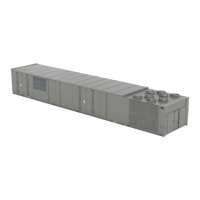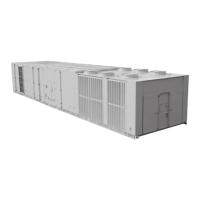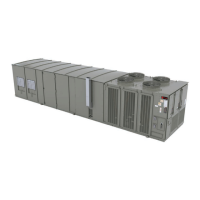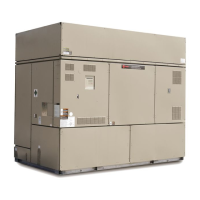RT-SVX073A-EN
37
to 500 microns or less. To establish that the unit is leak-
free, use a standing vacuum test. The maximum
allowable rise over a 15 minute period is 200 microns. If
the rise exceeds this, there is either still moisture in the
system or a leak is present.
10. Charge the system per the unit nameplate field charge.
Do not add refrigerant in the suction line at this time to
prevent excessive refrigerant in the low side prior to
compressor start-up.
11. At the liquid line angle valve add as much R-410A
LIQUID as possible. Depending on conditions, it could
not be possible to add more than 60% of the field
charge. This will be adequate for compressor start-up.
More charge will be added after compressors are
started. Use an accurate scale to measure and record
the preliminary amount of R-410A added to each
circuit.
12. With all the circuit compressors operating, SLOWLY
meter R410-A into the suction line from the LIQUID
charging connection.
Electric Heat Wiring Connection
WARNING
Proper Field Wiring and Grounding
Required!
Failure to follow code could result in death or serious
injury.
All field wiring MUST be performed by qualified
personnel. Improperly installed and grounded field
wiring poses FIRE and ELECTROCUTION hazards. To
avoid these hazards, you MUST follow requirements
for field wiring installation and grounding as
described in NEC and your local/state/national
electrical codes.
Important: For units with electric heat, complete tubing
connections AFTER completing wiring
connections. See “Tubing Connections”
section.
1. Cut and remove wire ties which hold the electric control
wires together, remove the shield bracket. Leave the
armaflex on the hole with the control wires.
2. Cut the lowest wire tie which holds the electric heat
power wires to the vertical post on the high side.
3. Route the power wires one by one in to the hole on the
low side end panel and connect them to the terminal
block inside the electric Junction Box or inside the
extended casing section.
Note: For 8' extended casing units, remove the panel
(this panel weighs approximately 60 pounds)
next to the corner post in the low side to locate
the terminal block.
4. Bundle the electric heat power and control wires with
armaflex wrap on the low side end of the unit. Screw
the shield bracket to compress the wire bundle and
create a good seal, see Figure 19, p. 38.
5. Route the electric heat control wires to the Junction box
located on the high side, see Figure 19, p. 38.
Power and Control Wiring Connections
Note: Complete Power and Control Wiring Connections
after the tubing connections are complete.
1. Discard the clamps and the wire shield which hold the
power and control wires.
2. Make the power and the control wire connections and
route the wires such that they route straight from the
hole at the bottom of the air handler, turn at right angles
and straight up through the bottom of the high voltage
junction box on the condenser side, see Figure 19, p.
38.
3. Assemble the louvered panels and the corner panels in
the condenser side back in place.
4. Screw the side panels to both the air handler and
condenser side panels to act as filler panels.
5. Finally, assemble the top cover back in place.
Figure 18. Wire routing at low side end wall
Rain Shield Bracket
Armaflex with
Wire Ties
Electric Heat Power
and Control Wires
Installation

